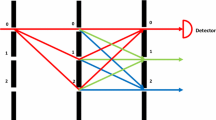Abstract
Quantum computing offers new concepts for the simulation of complex physical systems. A quantum computing algorithm for electromagnetic field simulation is presented here. The electromagnetic field simulation is performed on the basis of the Transmission Line Matrix (TLM) method. The Hilbert space formulation of TLM allows us to obtain a time evolution operator for the TLM method, which can then be interpreted as the time evolution operator of a quantum system, thus yielding a quantum computing algorithm. Further, the quantum simulation is done within the framework of the quantum circuit model of computation. Our aim has been to address the design problem in electromagnetics—given an initial condition and a final field distribution, find the structures which satisfy these. Quantum computing offers us the possibility to solve this problem from first principles. Using quantum parallelism we simulate a large number of electromagnetic structures in parallel in time and then try to filter out the ones which have the required field distribution.
Similar content being viewed by others
References
Abrams, D., Lloyd, S.: Nonlinear quantum mechanics implies Polynomial-Time solution for NP-Complete and #P problems. Phys. Rev. Lett. 81(18), 3992 (1998). doi:10.1103/PhysRevLett.81.3992. http://link.aps.org/abstract/PRL/v81/p3992. Copyright (C) 2009 The American Physical Society; Please report any problems to prola@aps.org
Averin, D.: Quantum computing and quantum measurement with mesoscopic Josephson junctions. Fortschritte der Physik 48(9–11), 1055–1074 (2000). http://dx.doi.org/10.1002/1521-3978(200009)48:9/11<1055::AID-PROP1055>3.0.CO;2-1
Barenco A.: Quantum physics and computers. Contem. Phys. 37(5), 375–389 (1996)
Barenco A., Ekert A., Suominen K., Torma P.: Approximate quantum Fourier transform and decoherence. SIAM J. Comput. Phys. Rev. A 54, 139 (1994)
Berggren K.: Quantum computing with superconductors. Proc. IEEE 92(10), 1630–1638 (2004)
Berman G.P., Ezhov A.A., Kamenev D.I., Yepez J.: Simulation of the diffusion equation on a type-II quantum computer. Phys. Rev. A 66(1), 12,310 (2002)
Childs, A., Cleve, R., Deotto, E., Farhi, E., Gutmann, S., Spielman, D.: Exponential algorithmic speedup by quantum walk. quant-ph/0209131 (2002). doi:10.1145/780542.780552. http://arxiv.org/abs/quant-ph/0209131. Proceedings of the 35th ACM Symposium on Theory of Computing (STOC 2003), pp. 59–68
Christopoulos C.: The Transmission Line Modeling Method TLM. IEEE Press, New York (1995)
Christopoulos, C., Russer, P.: Application of TLM to EMC problems. In: Uzunoglu, N., Kaklamani, D.I., Nikita, K.S. (eds.) Applied Computational Electromagnetics, NATO ASI Series, pp. 324–350. Springer, Berlin (2000)
Christopoulos, C., Russer, P.: Application of TLM to microwave circuits. In: Uzunoglu, N., Kaklamani, D.I., Nikita, K.S. (eds.) Applied Computational Electromagnetics, NATO ASI Series, pp. 300–323. Springer, Berlin (2000)
Coppersmith, D.: An approximate Fourier transform useful in quantum factoring. Arxiv preprint quant-ph/0201067 (2002)
Deutsch D.: Quantum theory, the church-turing principle and the universal quantum number. Proc. Roy. Soc. Lon. A 400, 97–117 (1985)
DiVincenzo, D.: Quantum computation. Science 270(5234), 255–261 (1995). doi:10.1126/science.270.5234.255. http://www.sciencemag.org/cgi/content/abstract/270/5234/255
Ekert, A., Jozsa, R., Marcer, P.: Quantum algorithms: Entanglement-Enhanced information processing [and discussion]. Philosophical Transactions: Mathematical, Physical and Engineering Sciences, pp. 1769–1782 (1998)
Feynman, R.: Simulating physics with computers. Int. J. Theore. Phys. 21(6), 467–488 (1982). doi:10.1007/BF02650179. http://dx.doi.org/10.1007/BF02650179
Freiser M., Marcus P.: A survey of some physical limitations on computer elements. IEEE Trans. Magn. 5(2), 82–90 (1969)
Grover, L.K.: Quantum computers can search arbitrarily large databases by a single query. Phys. Rev. Lett. 79(23), 4709 (1997). doi:10.1103/PhysRevLett.79.4709. http://link.aps.org/abstract/PRL/v79/p4709. Copyright (C) 2009 The American Physical Society; Please report any problems to prola@aps.org
Grover, L.K.: Quantum computing: beyond factorization and search. Science 281(5378), 792–794 (1998). doi:10.1126/science.281.5378.792. http://www.sciencemag.org
Hoefer W.J.: The transmission line matrix method-theory and applications. IEEE. Trans. Microw. Theory. Tech. 33, 882–893 (1985)
Knill E.: Quantum computing with realistically noisy devices. Nature 434, 39–44 (2005)
Krumpholz M., Russer P.: A field theoretical derivation TLM. IEEE. Trans. Microw. Theory. Tech. 42, 1660–1668 (1994)
Krumpholz M., Russer P.: Two dimensional FDTD and TLM. Int. J. Numeri. Modell. 7, 141–153 (1994)
Lloyd, S.: Universal quantum simulators. Science 273(5278), 1073–1078 (1996). doi:10.1126/science.273.5278.1073. http://www.sciencemag.org/cgi/content/abstract/273/5278/1073
Marinescu D.C., Marinescu G.M.: Lectures on Quantum Computing. Computer Science Department, University of Central Florida, Florida (2003)
Meyer D.A.: Quantum computing classical physics. Philos. Trans. R. Soc. Lond. A 360, 395–405 (2002)
Nielssen M.A., Chuang I.L.: Quantum Computation and Quantum Information. 1st edn. Cambridge University Press, Cambridge (2000)
Pravia M.A., Chen Z., Yepez J., Cory D.G.: Experimental demonstration of quantum lattice gas computation. Quantum Inf. Process. 2(1), 97–116 (2003)
Russer P.: Electromagnetics, Microwave Circuit and Antenna Design for Communications Engineering. 2nd edn. Artech House, Boston (2006)
Russer P., Krumpholz M.: The Hilbert space formulation of the TLM method. Int. J. Numeri. Modell. 6, 29–45 (1993)
Shor, P.W.: Algorithms for quantum computation: discrete logarithms and factoring. In: Proceedings of 35th Annual Symposium on Foundations of Computer Science, 20–22 Nov. 1994, pp. 124–134 (1994)
Shor, P.W.: Polynomial-time algorithms for prime factorization and discrete logarithms on a quantum computer. SIAM Rev. pp. 303–332 (1999)
Steane A.: Quantum computing. Rep. Prog. Phys. 61, 117–173 (1998)
Taylor, J., Lukin, M.: Dephasing of quantum bits by a Quasi-Static mesoscopic environment. Quantum Inf. Process. 5(6), 503–536 (2006). doi:10.1007/s11128-006-0036-z. http://dx.doi.org/10.1007/s11128-006-0036-z
Yepez J.: Lattice-gas quantum computation. Int. J. Modern Phys. C-Phys. Comp. 9(8), 1587–1596 (1998)
Yepez, J.: Quantum computation of fluid dynamics, Lecture Notes in Computer Science, vol. 1509, pp. 34–60. Springer, Heidelberg (1999). doi:10.1007/3-540-49208-9-3
Yepez, J.: Quantum lattice-gas model for computational fluid dynamics. Phys. Rev. E 63(4), 46,702/ 1–18 (2001)
Yepez J.: Quantum lattice-gas model for the diffusion equation. Int. J. Modern Phys. C-Phys. Comp. 12(9), 1285–1304 (2001)
Yepez J.: Type-II quantum computers. Int. J. Modern Phy. C-Phys. Compu. 12(9), 1273–1284 (2001)
Yepez J.: Quantum lattice-gas model for the burgers equation. J. Stat. Phys. 107(1/2), 203–224 (2002)
Author information
Authors and Affiliations
Corresponding author
Rights and permissions
About this article
Cite this article
Sinha, S., Russer, P. Quantum computing algorithm for electromagnetic field simulation. Quantum Inf Process 9, 385–404 (2010). https://doi.org/10.1007/s11128-009-0133-x
Received:
Accepted:
Published:
Issue Date:
DOI: https://doi.org/10.1007/s11128-009-0133-x




